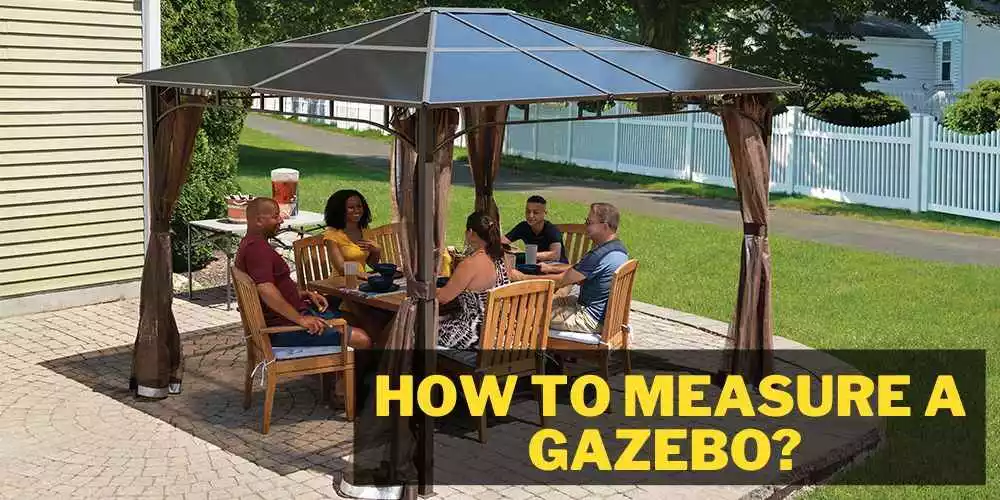Gazebos add a nice touch to any home or backyard area. They can be utilized as a zen space or integrated with a garden so that vines and climbers grow all over and around them.
But, it’s important to learn how to secure a gazebo from wind on concrete, otherwise it can create a mess that you don’t want.
Many combinations of materials can be used to assist in securing a gazebo on concrete, including support beams or sandbags. One of the most important materials, though, should provide a good quality foundation.
In most cases, it’s hard to argue with concrete to perform such a function. Especially when the gazebo can be subject to extreme weather conditions such as high winds; in this article, we’ll walk through the process of securing a gazebo using concrete to help mitigate any damage caused by high winds.

I have written this guide in a such a way that even a non-professional can follow it without any hassle. So if you’re willing to learn it on your own, then you won’t be disappointed. That’s a guarantee.
How To Secure A Gazebo From Wind On Concrete? (An Easy Guide)
Heavy duty reinforcement may be required depending on how the gazebo will be used. Some popup gazebos types might only need sandbags to keep them stable.
Those built as a permanent structure should be anchored upon a strong foundation such as concrete. If not properly anchored, gazebos act almost like a kite. Strong winds can easily sweep them off the ground and blow them around. This makes them a hazard to your home and any nearby people.
Smaller concreting projects aren’t overly complicated. However, they may be overwhelming for a beginner. Therefore, if you’re not skilled in that construction area, it’s best to hire a professional to complete the job.
They can plan for the correct dimensions for your gazebo, removing any guesswork.

More often than not, the concrete will need to be a certain thickness, and the correct reinforcement must be added to improve the overall strength. Regardless, let’s look at the process required to secure a gazebo into concrete to stop the wind from picking it up and throwing it around.
Things Required:
- A pre-planned, measured, formed, and poured concrete slab
- Gazebo
- Attachment parts (they are usually already pre-installed, but some models need an extra part to allow floor mounting).
- Spirit level
- Hammer
- Hammer drill, normal hand drill, and ratchet drill (or hand ratchet kit)
- Pilot masonry drill bit (¼ inch)
- A masonry drill bit that suits the size of the bolt you will fasten with (½ inch)
- Pilot steel bit (¼ inch) – This may be necessary depending on the models’ inclusions
- Steel bit that is the same size as the final concrete drill holes (½ inch)
- Lag Screws (¼ inch X 1 ¼ inch)
- Lag Shields/Plugs (¼ inch X 1 inch)
Step By Step Guide On How To Secure A Gazebo From Wind On Concrete
This article is based on securing the gazebo to the concrete slab. Therefore we will focus specifically on that process alone. There are many ways to create a concrete slab, so it’s best to leave that process to an entirely different article.
The simplest but most effective steps you can take to secure a gazebo to the concrete are as follows:

- Align – Maneuver the gazebo into place (you may need help) and line it up so it is in the desired position. Use the spirit level to double check that it is sitting flat and straight.
- Additional parts – Most gazebos will come with everything required so that you can just drill a few holes and secure them down. It’s not always the case, so add any additional parts that may be required to do so. They will generally come with instructions. If not, it’s best to consult with the manufacturer.
- Most models will come with pre-drilled holes in a steel base flange. If not, you may also need to drill those out using a steel drill bit. Use a smaller pilot hole bit, then follow that up by using a bit that is the same size as the final concrete bit.
- Markout – Markout 4 holes into the concrete through the flange holes on each upright beam. There is usually 1 on each corner. It’s best to mark them out so that if the gazebo moves, you can easily line it back up by lining the markings up.
- Drill – Using the masonry pilot bit, drill holes through the steel flanges into the concrete. Then go around and use the larger bit to drill the holes to the correct size.
- Plug the holes – Use a hammer to tap a lag shield/plug into each hole.
- Bolt it down – Finally, with the gazebo and shields in place, add a screw into each hole and fasten it using either a hand or powered ratchet.
That’s pretty much it! Double check to ensure the gazebo is still flat and straight. Depending on the model, you may need to add support between the beams. In general, though, gazebos are usually pretty sturdy once bolted down to the concrete. Enjoy!
How do you anchor a gazebo to concrete without drilling?
Fastening a gazebo to concrete via drilling is usually the best method. However, it’s not the only way to ensure it won’t fly away with the wind. It’s possible to use a similar tactic as drilling but use a really strong silicone or glue as a finishing material to anchor a gazebo to concrete without drilling.
Both surfaces may need to be primed before adding the fastening agent.

Most other methods involve improvising using a weight evenly distributed around the outside of the gazebo. Some other notable anchor items include:
1. Sandbags
Sandbags are pretty common when setting up and using portable gazebos. Some gazebos come with built in or attached bags around the base that you can fill with a heavier material such as sand.
Alternatively, you can purchase heavy duty bags and fill them with sand. These can be placed against the gazebo legs (upright beams) or tied off further outside the gazebo. The latter will allow much more space for the user.
2. Gym weights
Gym weights are another great option. The heavier, the better. The upside to using gym weights is they are usually easy to maneuver. They are designed for people to use daily, so it’s usually not a big deal to add some rope to the rings in the weights and tie the other end to the corners or sides of the gazebo.
3. Large Pot Plants
The soil used to pack a plant into a pot is usually heavy enough to be used as a counterweight for a gazebo. Furthermore, using one on each side or corner and evenly distributing the counterweight can work as a really good anchor to help mitigate strong winds.
The common theme here is tying down a heavy item on each side to secure the gazebo in place. Some other options may include heavy furniture such as tables, chairs, or sun lounges. Even vehicles such as trailers or car tow balls can be used as a tie off point for stable anchoring.
You May Also Find Helpful: Does a gazebo add value to your home
Frequently Asked Questions (FAQs)
Can you anchor a gazebo to concrete?
Anchoring a gazebo to a concrete slab is one of, if not the best, fastening methods possible. Doing so will give you a level gazebo base. It’s also extremely low maintenance and super clean. Furthermore, it is a great base for any possible fixed paving, such as tiles or pavers.
What is the best way to anchor a gazebo to concrete?
The best way to anchor a gazebo to concrete is by bolting it down. It’s as simple as moving your gazebo into place, drilling some pilot holes followed by final sized holes, bashing in some plugs, and fastening the bolts or screws from the topside of the gazebo feet. This method will help prevent the gazebo from blowing around in strong winds.
Which is better: wedge anchor or sleeve anchor?
It depends on the type of material that you wish to fasten to. Wedge anchors only work in concrete but are extremely effective in this case. Sleeves can be used in concrete, wood, bricks, drywall, etc. They are still very strong but can move around if the fixed item pulls and shakes while in place.
How much weight is needed to anchor a gazebo?
This question can be loosely answered using variable metrics such as the size of the gazebo as well as the strength of the wind. Furthermore, the strength and quality of the gazebo can also play a large role. As an example, it’s fair to say that a small 10 x 10, standard size and model gazebo may need around 40 lbs (18 kg) on each corner. Double the weight on each corner for a 10 x 20 size. Continue this pattern as the size increases.
How do you install anchor bolts in an existing concrete foundation?
The simplest way to achieve this is by first moving the gazebo into place and marking out the holes in the concrete where the bolts will go. Drill out the holes first with a smaller pilot bit, then follow that up with a bit the size of the bolts or screws. Tap in some plugs to help reduce movement, then screw in the fasteners with the gazebo in place. Tighten and enjoy!
What is the best anchor for concrete?
Wedge anchors generally offer the tightest fix. They are designed for concrete only and do a damn good job once locked in place. Sleeve plugs are another great option. They help to minimize movement from pulling and shaking whatever has been anchored to the concrete.
Conclusion
The best quality foundation is always going to be concrete. It’s easy to get flat, the maintenance is a breeze, and it keeps an undercover area clean. Lastly, it’s almost unbreakable if constructed the correct way.
Understanding how to secure a gazebo from wind on concrete will help prevent your gazebo from being picked up and thrown around by heavy winds. We hope this article has been helpful, and we look forward to seeing you at the next one! Thanks for tuning in!


